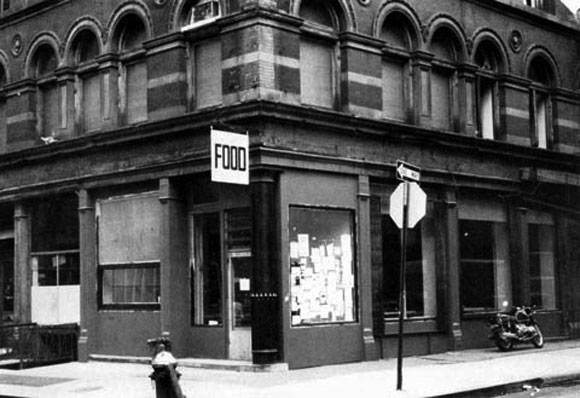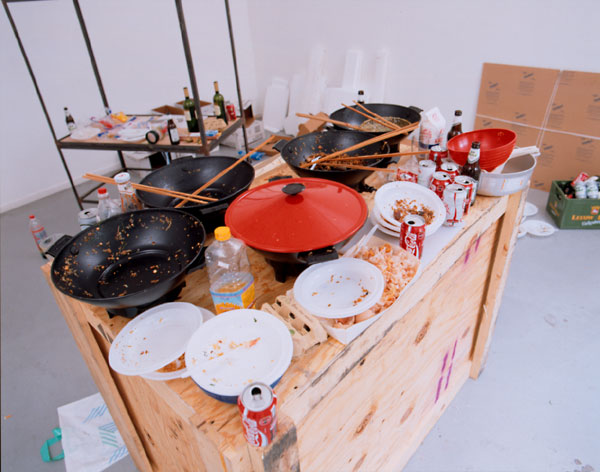Cooking Invocation
June 10, 2010
By Tobey Albright

Gordon Matta Clark, "Food," 1971
French food critic Grimod de La Reynière
Rirkrit Tiravanija’s Untitled 1992 (Free), at 303 gallery in New York
Alison Knowles’ Make a salad (1963)
Gordon Matta Clark’s Food (1971)
Max Frey’s pasta kitchen for his participation in Jeppe Hein’s Circus Hein at Open Space / Art Cologne 2010
Jennifer Rubell’s participatory large-scale food projects
Apartmento Magazine’s project FoodMarketo
Jan Verwoert’s Living with Ghosts: From Appropriation to Invocation in Contemporary Art
Celebrity head chef Ferran Adrià of El Bulli restaurant
Piero Manzoni’s Artist’s Shit (1961)
Two centuries ago, the French food critic Grimod de La Reynière once stated, “only the vulgar would see no more to kitchen than saucepans and no more to dinner than dishes.” He also went on to state that the gastronomic arts “embrace all three realms of nature, and the four corners of the globe, all moral considerations and all social relationships.”1 With this claim, La Reynière was keen on opening up a historical discourse for food and its preparation. However, it is important to note that these claims were made primarily in light of enjoying the effects of cooking (eating) as opposed to reveling in their production. Today, the transfiguration of the cooking process is becoming a highly visible artistic strategy for addressing the art stage’s [i.e. institution, gallery, etc.] discursive impact on the differences between art and the everyday.
Preparing food is clearly a universal activity. The activity behaves differently within specific cultural and social scenarios, but ultimately it operates with the same openness and consumable portability as any human behavior. Like most behaviors that pass through the homogenizing mechanics of economy and media, the essential ‘togetherness’, or sharing of the unspectacular exchange of cooking, is referenced again and again in public situations that claim its ‘togetherness’ as a means of relational authenticity. And while cooks have historically been in the background, behind the scene of the meal, representing the process in the foreground opens this claim of authenticity wider through a rhetoric of transparency. Thus, the cooking process, when performed by bodies of artistic merit in artistic situations, dislodges the work’s immediate interpretability (homogenized education via the institution), through manifesting a re-emergence of the everyday in artistic practice. The medium of the everyday is a highly appropriated convention in visual art, threaded among Relational Aesthetics, Abstract Expressionism, the Fluxus and Dadaist movements, Impressionism, Realism, etc.
Let’s take for instance one of the more commonplace users of this cooking strategy in recent history, Rirkrit Tiravanija. Regarding his artistic production, Tiravanija states, “I started to make things so that people could use them … [My work] is not meant to be put out with other sculpture or like another relic to be looked at, but you have to use it …”2 With such PR, the artist invites the viewer to become an everyday participant, or user, of his specific interventions, by situating them within a conceptual context that mirrors the “symbolic value” of global capitalism, i.e. behavioral appropriation. Tiravanija specifically used cooking in his work Untitled 1992 (Free) at 303 gallery in New York. In this work, Tiravanija cooked Thai curries for the visitors and left the ‘ready-made’ scattered leftovers, kitchen utensils and used food packets as relics in the gallery when he was not present and cooking. The process, or durational quality of the performance, was presented as the material in which the participant could locate the “symbolic value” of the artist’s relational medium. The cooking itself in this performance could be seen as a means by which the artist strategically offers a generous act, as opposed to another alienating mono-dimensional consumer relationship, typically characterized by and found in a gallery space.
Additional users of the cooking strategy include the likes of Fluxus artist Alison Knowles, with her proposition to “Make a salad” (1963),3 and Gordon Matta Clark’s restaurant “Food” (1971),4 which he opened with fellow artists. More recently, appropriation of the cooking strategy can be seen at art fairs, such as Max Frey’s Pasta Kitchen5 as his chosen mode of participation in Jeppe Hein’s Circus Hein at Open Space / Art Cologne 2010. And following the cooking-as-circus-side-show theme, Jennifer Rubell, the artist and daughter of mega-collectors, Don and Mera Rubell, Jennifer Rubell,6 uses the cooking strategy as gastronomical class theatrics in her installations/happenings that mirror the extravagance of gala dinners and gallery openings through a supposed loss of procedural order. Additionally, the cooking strategy can even be seen in the PR event of a trendy lifestyle periodical, Apartmento Magazine’s project “FoodMarketo.”7 In this latter instance, the open-cooking scenario was used as “an everyday life market” and as a means to sell independent designer kitchenware. In each of these recent cases, the employment of the cooking strategy as an institutional or commercial alternative for congregation is made strikingly clear through their simplistic appropriation of the performance of cooking.

The American Spaghetti alla Bolognese "Balloney" and The Invocation Table
A playful way to consider cooking’s invocation of appropriation is most readily accessible when we not only focus on the production of artists, but also on the appropriation apparent within the culture of cooking itself. For instance, spaghetti alla bolognese is a dish that exists as an international by-product of several generations of appropriation. What would be a bright-red meat sauce atop thin noodles, this dish never came to be within Italian culture because Italians consider spaghetti the wrong shape to hold a meat sauce. You’re more likely to get a bolognese sauce with tagliatelle in Bologna, with penne, fettucine, or with lasagna noodles in a dish of lasagna. Yet, the extent to which the dish has been appropriated, and the abstraction of identity through exchange, is most comically visible in the Americanized version of spaghetti bolognese, sometimes referred to as spaghetti “baloney.”8 In the closing paragraph of Jan Verwoert’s Living with Ghosts,9 he states that, “Appropriation is about performing the unresolved by staging objects, images or allegories that invoke the ghosts of unclosed histories in a way that allows them to appear as ghosts and reveal the nature of the ambiguous presence.” Unless we’re sitting down for a meal prepared by celebrity chef Ferran Adrià, we intuitively recognize that the content responsible for informing the meal was produced via appropriation, or with the assistance of the ghosts of previous meals. Therefore, the very nature of cooking, using recipes and adapting them to one’s individual tastes, metaphorically activates the same adaptations as a cooking gallery performance by using the bodies involved as performative vessels capable of realizing the machinistic development of history and its increasing specialization of experience. Cooking is a form of invocation that sustains collective identity through appropriation and grants its user a momentary opportunity to claim authorship of this community in lieu of an institution, offering the experiential framework of shared autonomy while performing a criticality of the everyday.
Cooking, when distilled through the critical apparatus of visual art, becomes as collaboratively reductive as its intention of resolving hunger. The process must be actualizing because hunger MUST be satisfied. Cooking bodies swarm around the meal’s work space as they follow the script that will lead them to a state of bodily agreement and satisfaction. At times, a single body will improvise and/or direct the other bodies towards an alteration of the script, ultimately performing a meal that transgresses the historical signature of its recipe. In ideal situations, this improvisation can occur co-actively, in which case the emotional framework for consuming the meal becomes that much more orgiastic and mystical. In this way, the operational appropriation inherent in cooking would bestow on the activity the means by which everyone seems to be able to get what they need, while potentially adapting those needs to what they want. When everyone gets to walk away from a meal with something, the anxiety of provisional politics (e.g. who the provider is) is temporarily resolved in the sharing. This sharing framework is then capable of providing an alternative, yet similar, framework for consuming visual art. But, as with all art, the digestive resolution will behave particular to the biology of the person consuming it. Thanks to Piero Manzoni, the value of the final product will always remain a little illiquid.

Piero Manzoni, "MERDA D'ARTISTA" 1963
1 Giles MacDonogh, A Palate in Revolution: Grimod de la Reyniere and the Almanach des Gourmands, UK: Robin Clark, 1987. 185-6. Print.
2 Rirkrit Tiravanija, quoted in Janet Kraynak (1998) ‘Rirkrit Tiravanija’s Liability,’ Documents, no. 13, p.36.
3 Alison Knowles’ Make a salad (1963)
4 Gordon Matta Clark’s Food (1971)
5 Max Frey’s pasta kitchen for his participation in Jeppe Hein’s Circus Hein at Open Space / Art Cologne 2010
6 Jennifer Rubell’s participatory large-scale food projects
7 Apartmento Magazine’s project FoodMarketo
8 RAGU’ ALLA BOLOGNESE (Bolognese sauce)
A “ragu Bolognese” style is a meat sauce that is slow simmered for at least an hour to develop a complex flavor and proper thickness. Cooking the ragu in a heavy-duty enamel or similar pot will hold the heat steady and help to give a velvety texture to the ragu. Bolognese ragu is a classic sauce for lasagne and tagliatelle. The sauce also freezes beautifully. Bolognese sauce (“ragù alla bolognese” in Italian) is a meat- and tomato-based pasta sauce originating in Bologna, Italy. The sauce is typically made by simmering ground meat in tomato sauce, white wine, and stock, for a long time (often upward of four hours), so that the meat softens and begins to break down into the liquid medium. The original sauce is not done with minced meat; instead, whole meat, usually beef or veal, is chopped with a knife. Spaghetti alla Bolognese, or spaghetti bolognese which is sometimes further shortened to spag bol, is a dish invented outside of Italy consisting of spaghetti with a meat sauce. In Italy, this sauce is generally not served with spaghetti because it tends to fall off the pasta and stay on the plate. Instead, the people of Bologna traditionally serve their famous meat sauce with tagliatelle (tagliatelle alla bolognese). Outside the traditional use, this sauce can be served with tubular pasta or represent the stuffing for lasagna or cannelloni. While “Bolognese” is undoubtedly the most popular ragù in this country, it is also the most misunderstood. The ragù you get by that name is usually a characterless tomato sauce with pea-like bits of ground beef floating in it, bearing little resemblance to anything you’d find in Bologna. And not, in any sense, a ragù. True ragù alla Bolognese contains no tomato sauce — just enough fresh or canned tomato to add a hint of sweetness and another layer of flavor to a subtle, complex mix.
Like all ragùs, Bolognese is characterized by its long, slow cooking, which in this case starts with simmering the meat in milk (to mellow the acidity of the raw tomatoes added later) and wine (some use white, others red), after which the tomatoes are added. The whole lot is cooked together for about two hours. www.bolognacookingschool.com
9 Jan Verwoert’s Living with Ghosts: From Appropriation to Invocation in Contemporary Art
» Co-working
⊕
Comments Off on Cooking Invocation


